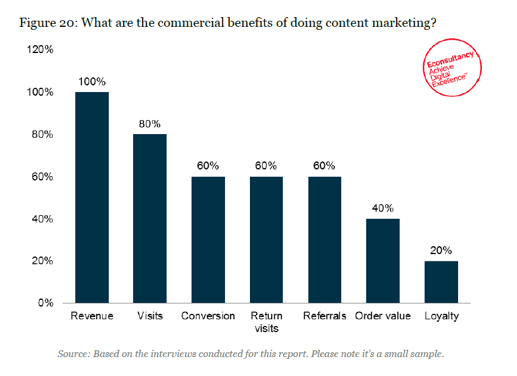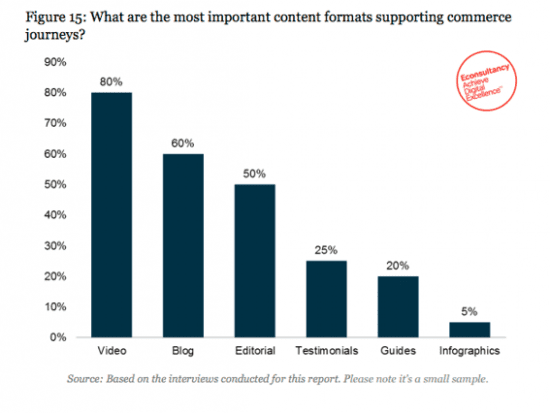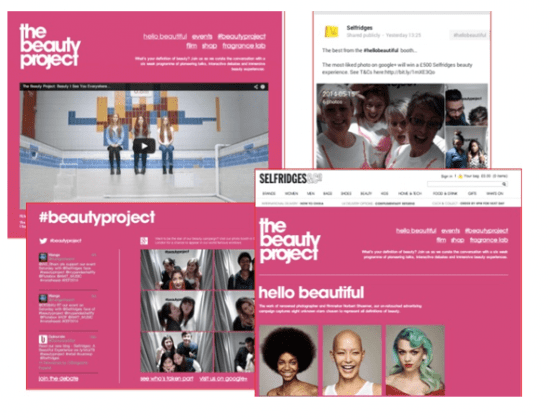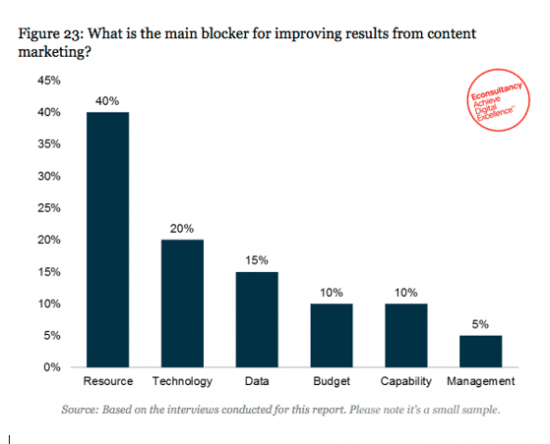Examples and research showing why content marketing is now key for driving Ecommerce customer journeys
Ecommerce is constantly evolving alongside the development of new digital media and technologies, yet one aspect has not changed. That is, the importance of search intent in the buyer journey. Consumers continue to use search to find, research and buy the products that they want.
However, though this basic fact may not be changing, the way search works is. Search algorithms and in particular those by Google are regularly updated to focus more on quality and relevance of content. So now ecommerce businesses have to think differently about content's position in the buyer journey.
Long gone are the days of keyword density, link farms and ghost pages. Want your products to rank well for search? You need quality content.
The intersection of content marketing and ecommerce
How are ecommerce businesses using content marketing? New research from Econsultancy and EPiServer shows an increasing importance attached to content marketing :
In ecommerce, 60% companies see content engagement increasing and 30% of companies plan to invest more in creating original and unique content. They are making this investment to stay ahead of competition, as well as a way to improve SEO.
Of course the trend is not just one affecting ecommerce, content marketing is now a tactic deployed across a broad variety of sectors. But it has particular value for ecommerce, and ecommerce companies are already seeing real value from a financial perspective. They are starting to realise that content is the conduit for merchandising, and many are putting more emphasis in creating high quality product and editorial content that fits with their customers’ lifestyle interests as a way to help drive ecommerce journeys.
No wonder all of the companies interviewed in the recent Econsultancy and EPiServer report have cited increased revenue as a commercial benefit of doing content marketing.

What do we mean by content marketing for ecommerce?
'Content' can play many roles in an ecommerce context. We're seeing a rise of editorial and curated merchandise, where brands have identified the need to engage customers around lifestyle elements or interest areas and not just sell products. Content is playing a key role in educating, inspiring and seducing customers in this way.

A lifestyle-focused content sharing example
Take our customer Norrøna, a high end outdoor clothing brand who has recently re-launched their website to combine the content and commerce experience. They believe that the story of the sports (snowboarding, skiing, biking etc) can be as important as the product (outdoor clothing) itself.
The editorial follows various professional ambassadors in outdoor and snowsports. An example piece of content features Andreas Wiig, a famous professional snowboarder, on a trip to Japan to review the snow condition and local culture. A video shows him on the ski slopes with his Japanese host, alongside information about how to get to the island of Hokkaido and curated product merchandise to match.

An Interest focused content sharing example
Another of our customers Key Music, a music retailer operating in several regions across Europe, is a particularly strong example here. As musicians are invariably passionate about their past time, Key Music saw an opportunity to use specialist content to help it engage with its customers. The screenshot here is a branded landing page combining the brand story of Gibson and product merchandise with a video of the craftsmanship of Gibson guitars through a YouTube video. This example shows the page localised for the Netherlands.

This business also employs a network of freelance music writers who have specialist knowledge in the different areas its customers are interested in. Operating across several countries, they have specialists to deliver content across languages and interest areas.
A multichannel content marketing example
Selfridges’ Beauty Project makes great use of multichannel content marketing designed to drive sales through customer engagement. The campaign made use of in-store photo booth that streams content live into store window displays, live feed of content to Google+, campaign video content, iconic photography from well-known photographers and filmmakers and social hashtag #beautyproject to encourage customers interaction with the campaign via social media, in-store and online.

What are the challenges of content marketing?
Of course the drive towards content and commerce integration is not without it's challenges

The first is defining a solid content marketing strategy. The main difficulty of using content to 'sell without selling', is that, well, you do still want to sell. There is a tension between the content and the commerce aspects.
For example, how do you choose when to surface editorial content and when to surface product? The challenge is to define a strategy that finds a balance between the commercial and content aspects of the site and decide how are you going to measure it.
Ultimately, product has to be the primary focus for a commerce site, otherwise people can mistake the website for a magazine site. However, a site without content may actually dissuade some customers from coming back.
Good content can satisfy customer's research needs and help drive them towards the sale, so conversions (AOV/revenue) and engagement (dwell time/social shares/page per visit) KPIs should be used in conjunction to understand the true impact.
The second is simply resource. Creating great content is much easier said than done; it requires advanced skills and expertise, not to mention a lot of time. Finding the right skills is difficult, with 40% companies we interviewed cited difficulty in finding people who understand the brand values as a key challenge, as is coordinating content delivery and governing the tone of voice across international markets/teams.
Lastly, finding the right technology is crucial to deliver a personalised experience. The research has found that most companies interviewed have no clear technology roadmap around the variety of tools such as CMS, e-commerce platform, marketing automation and web analytics software they use.
Marketers are still struggling to deliver a consistent experience across channels, and 60% of companies interviewed agreed that the lack of single customer view (data gaps) is holding them back. The importance of technology in enabling rich content experiences that drive conversion should not be underestimated.
By defining a clear content marketing strategy and using the right technology, resource and expertise to deploy it, it is possible to use content not only to improve SEO rankings but to create more engaged and loyal customers.
You can hear more about integrating content and e-commerce at the Smart Insights Digital Impact conference on 17th September 2014 where Bob Egner, VP of Product Management at EPiServer will give more examples of how content can become part of the path to purchase.
 Thanks to David Bowen for sharing his thoughts and opinions in this blog post. David is an Architect for e-commerce solutions. Currently at EPiServer, David is Product Manager for all ecommerce products. He has been active in the ecommerce industry since 1999, working as a Solution Architect at system implementers, guiding over 50 solutions for mid-size and enterprise businesses. Based on experience with multi-million dollar global e-commerce solutions he uses commercial and technology knowledge to perform project scope and review architecture. David frequently speaks and writes on industry trends and is based in London UK.
Thanks to David Bowen for sharing his thoughts and opinions in this blog post. David is an Architect for e-commerce solutions. Currently at EPiServer, David is Product Manager for all ecommerce products. He has been active in the ecommerce industry since 1999, working as a Solution Architect at system implementers, guiding over 50 solutions for mid-size and enterprise businesses. Based on experience with multi-million dollar global e-commerce solutions he uses commercial and technology knowledge to perform project scope and review architecture. David frequently speaks and writes on industry trends and is based in London UK.










